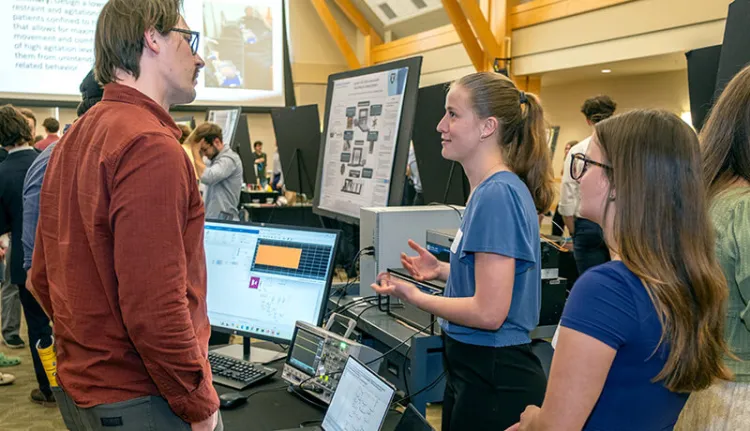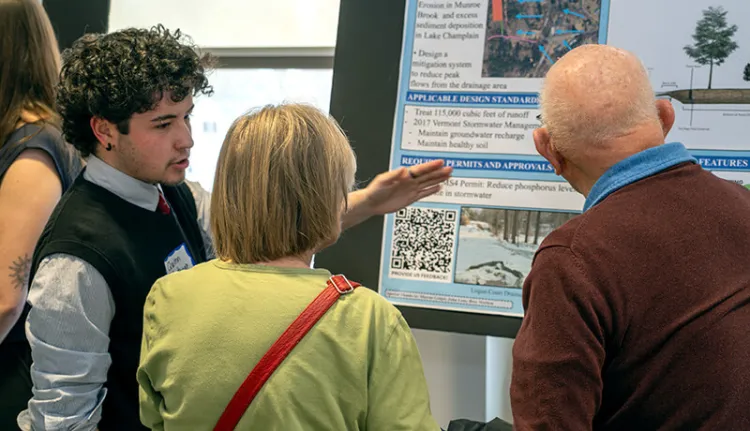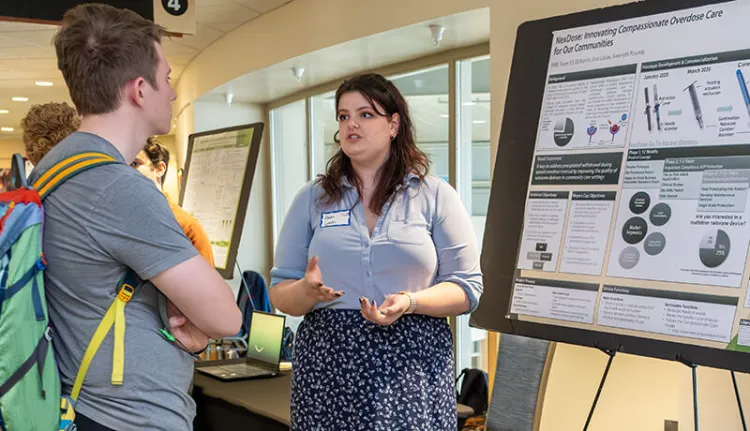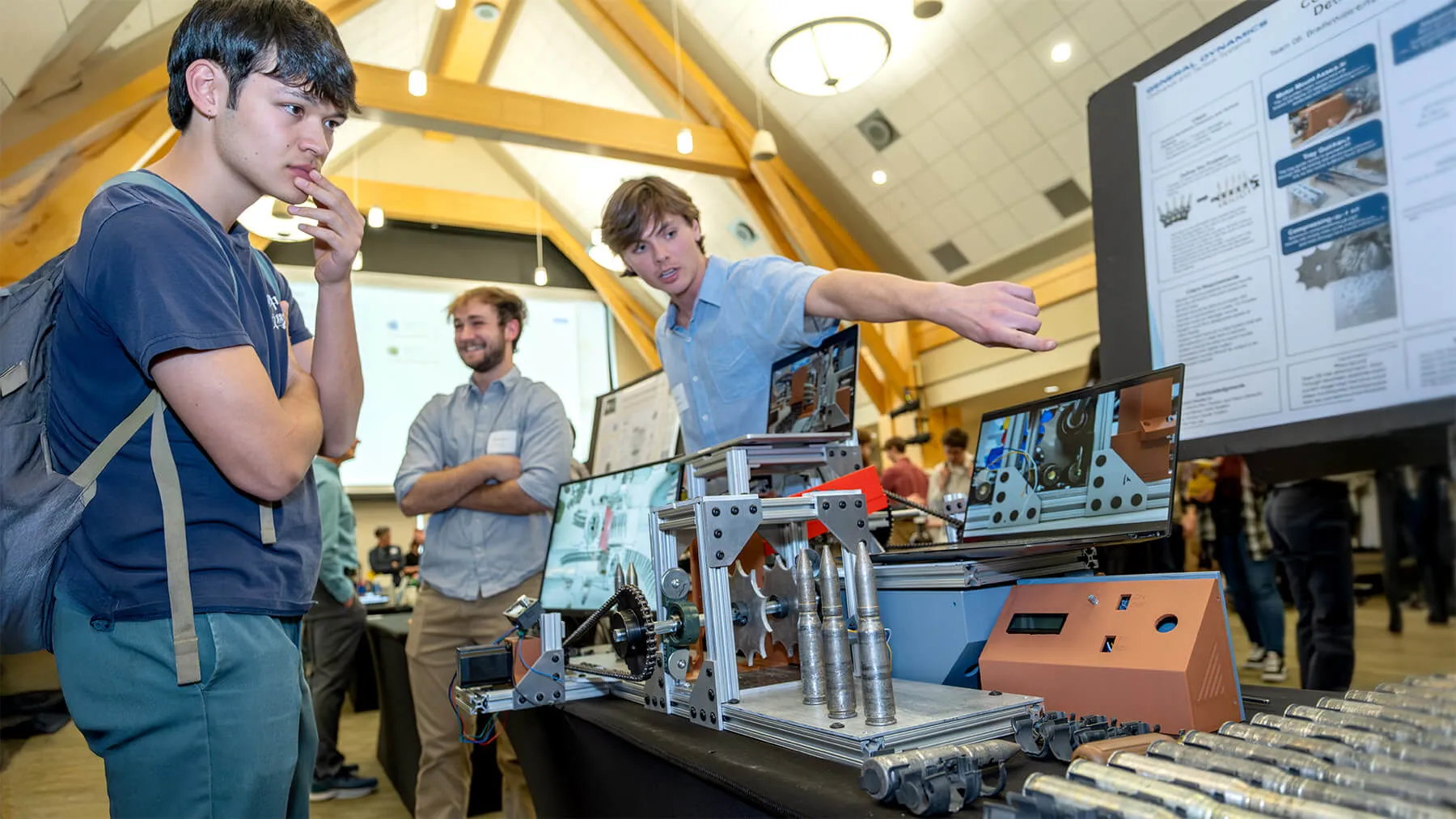Visitors to this year’s annual Engineering Design Night barely had enough time in the allotted two hours to tour and take in the remarkable display of engineering, design, and innovation of the many teams of soon-to-be graduating seniors in the Mechanical, Electrical, Biomedical, Civil, and Environmental Engineering programs.
A core component of the interdisciplinary and hands-on curriculum in the College of Engineering and Mathematical Sciences are the real-world engineering design projects that seniors in these programs tackle as the culminating “capstone” experience of their undergraduate journey at UVM.
A large crowd of students, faculty, and visitors navigated through a maze of tables that filled the top floor of the Davis Center and featured a diverse and impressive display of functioning prototypes and informative presentations that guided the viewer through the creative solutions each team had developed for the unique engineering challenge assigned to them.
The unique engineering disciplines were represented in separate groupings defined by their respective capstone course. Twenty-five teams of mechanical and electrical engineering students filled the Grand Maple ballroom with their projects developed for the Senior Experience in Engineering Design (SEED) program. In the nearby Livak Lounge, ten teams of civil and environmental students presented their capstone projects alongside three teams from the biomedical engineering program.

Mechanical and Electrical Engineering (Senior Experience in Engineering Design)
Co-led by professors Keith Epstein and Keith Doyle, the SEED program features teams of undergraduate Mechanical Engineering and Electrical Engineering students who collaborate to address complex, multidisciplinary problems. SEED projects originate as challenges shared by tech companies, non-profits, faculty, and UVM departments during a capstone pitch event held early in the fall semester.
Based on the nature of the challenge and the students' skills and backgrounds, teams are formed and paired with each problem. Epstein and Doyle then guide the students through the engineering design process. In addition, each student receives support from an assigned faculty mentor whose experience and research complement the challenge.
Over the course of their final year, the students work in teams to understand the challenge, design a solution, and build a functioning prototype, which they share during the college’s largest annual event, Engineering Design Night.
Here is a sampling of the diverse SEED projects that were on display:
- A portable machine that can process ash logs to create wood splints that members of Nulhegan Band of the Coosuk Abenaki People can process into traditional baskets. Sponsored by Abenaki Helping Abenaki.
- A test fixture used to characterize the flow behavior of various screens, filters, valves, and other parts that are used in spacecraft propulsion systems. Sponsored by Benchmark Space Systems.
- Perform structural analysis of a proprietary suspended platform system to better understand the forces and stresses associated with unique design layouts. Sponsored by BrandSafway.
- A device that can semi-automatically sharpen handheld tungsten carbide scribes used in semiconductor failure analysis labs. Sponsored by GlobalFoundries.
- A quick-change solution for different accessory heads used in professional-grade outdoor power equipment. Sponsored by DR Power Equipment.
- An autonomous weeding robot for farms/gardens that uses a 3D LiDAR to allow the detection of undesired plants and facilitates their removal. Sponsored by the University of Vermont.

Civil and Environmental Engineering (CEnvE) Senior Capstone Design:
Course instructors John E. Lens, PhD, PE, and Carolyn Carlson, PE worked alongside teaching assistant Hannah Kuleba to guide civil and environmental engineering students on their senior capstone design experience. This course features service-learning projects where students work with local communities, towns, and non-profits on their Civil and/or Environmental engineering-related needs.
Working in teams over a semester, the students address complex and multidisciplinary projects that originate as problems or needs statements submitted by their sponsor. For each project, the students investigate the client’s needs, consider multiple design alternatives, and ultimately arrive at a recommended solution based on costs and social and environmental impacts.
Some of the projects presented by CEE teams during the 2025 Engineering Design Night:
- Design on-street bike access to accommodate cyclists, pedestrians, and vehicles in Essex Junction, VT.
- Design a hydrogen sulfide remediation and treatment system to mitigate hydrogen sulfide generation in Middlebury, VT.
- Design alternatives to mitigate future large storm impacts on roadways and buildings along the Great Brook in Middlesex, VT.
- Design a drinking water system upgrade for an aging community water system in Sheffield, VT.

Biomedical Engineering (BME) Capstone Design:
Uniquely situated between the Larner College of Medicine, UVM Medical Center, and UVM’s state-of-the-art STEM complex, UVM’s BME program provides a senior capstone project learning experience where students can engage in interdisciplinary research, collaboration, and instruction focused on a biomedical engineering challenge.
Led by the Director of the Center for Biomedical Engineering (CBI), Yuri Hudak, and mentored by UVM and Larner faculty, this spring’s cohort of BME students faced design and engineering challenges unique to their discipline:
- A water-cooled prosthetic liner designed to address excessive heat buildup and enhance thermal comfort at the residual limb site in lower-limb transtibial amputee prosthetic users.
- A non-invasive forced-oscillation device to provide lung mechanic metrics in real time to help prevent Ventilator-induced Lung Injury.
- A reusable, intranasal naloxone delivery device designed to empower community workers and first responders.
View a complete listing of all the Biomedical Engineering projects, teams, and mentors.
